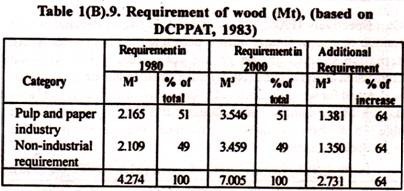timber extraction
Population explosion has its tremendous pressure on demand for goods and services in our country. The picture of consumption of wood in developing countries is exactly the reverse of the developed ones. In the former, wood is used 82% for firewood and 18% for industrial uses whereas in developed world these figures are 16% and 84% respectively (FAO, 1981).
In India firewood demand would continue to rise in future, mostly consumed in rural areas where alternative sources of energy, are yet to reach. The National Commission of Agriculture (NCA) could already indicate a substantial rise demand for wood by 2010 A.D. for fire wood and industry (Table 1 (B).8.). These demands may become still higher in future. Data in Table 1 (B).8. Show that increase in demand cannot be met from what we produce at present.
The demand for industrial and particularly fuel wood is thus increasing over time. Moreover we also require more wood for our fruit industry, tea, army, newsprint etc. In fruit and tea industry more wood would be needed for wooden crates and plywood board crates.
Paper board and newsprint industry also consume much of our wood. With increasing population growth our per capita consumption of paper is likely to increase from 2 kg to 4.5 kg per year. For paper and board, bamboos and hardwood are the chief sources (70%) of raw materials. Growing demand for 2.45 Mt will enhance dependence on bamboo and hardwood.
About 87.5% of wood are needed for firewood and about 10.5% for timber and only 2% for pulpwood (Table 1(B).8). The pulpwood is likely to go to nearly 8% of the wood requirement by 2010. Nearly 51% of the pulpwood today comes from bamboo (table 1(B).8). There is every possibility that there may be shortfall in wood and bamboo in 2010 A.D.
The situation may worsen due to population explosion and poor productivity of our forests. By 2010 shortfall in raw material for paper and board is expected to be nearly 0.30 Mt of air dry bamboo and 3.55 Mt air dry debarked woods.
Moreover mere has been substantial growth of newspaper industry. Per-capita requirements are likely to go up to 1.2 kg by 2010, thus the newsprint capacity needs to be raised to 1.4 Mt from the present, nearly 0.692 Mt.
Followings are the expected requirements of raw materials for newsprint:
It is presumed that the requirement of forests raw material will be nearly at 2 air dry ton per ton of newsprint. There is expected a shortfall which based on 25-75% mix of bamboo and hardwood works to 0.161 M and 0.925 M air dry ton of bamboo and hardwood respectively. Thus, raw material needs to be raised for future.
Equally, major demand on forests is the sustainability of water supply. All the water regimes of the country are in forest areas. Thus management of watersheds and catchments is vital for the country. Catchments are to be managed for regulated water yield by manipulation of forest cover, flood control and water quality. The present interlinking of rivers aim for this.
Afforestation- Strategy to Demands:
Top priority is to be given to the forestry. Forests occupy central position in nature. They restore ecological balance of all ecosystems (including desert), maintain biological diversity, act as catchments for soil and water conservation, prevent floods and safeguard future of tribals.
In order to meet such needs, we need to develop massive afforestation programmes of indigenous and exotic fast growing species for production and protection forestry on suitable land including wasteland. A massive social forestry programme is required to meet demand of local people for fuel, fodder, timber etc. to all wood based industry.
There is an important point in planning future forestry in the country. Unlike in the past when forests were solely be treated as revenue generation sector, the current strategies in forestry have to be healthy combination of environmental imperatives and production. If we consider forests simply as revenue source the gains are ephemeral accompanied by long term damage.
Today the two major goals for forestry are:
(i) Supply of goods and services to people and industry by a well thought outplan of production, and
(ii) Long term ecological security through conservation of forests cover and its restoration.
Holistic approach to Development:
There is a need of holistic understanding of the relationship between the environment and the development processes taking place in the country. Different persons from different walks of life to emphasise on a particular aspect. Journalists give prominent display to environmental horror stories. Editorials stress upon better i management of our natural resources. Government gives statements on the need to preserve the environment.
There are a number of such programmes initiated by government day by day. There are massive programmes of afforestation. Several thousand crore seedlings are said to have been distributed or planted. There are new laws to control air and water pollution and for conservation of forests, wildlife and biosphere reserves in the country. Plan documents and party manifestos are careful towards environment.
However, there is a major problem with this entire range of concerns and activities. It does not appear to be based on a holistic approach i.e. taking the process of development and environment as a unit. For these programmes a concern for environment essentially means to protect and conserve it partly through development programmes, and in most cases for the benefit of handful local population.
There is little effort to modify the development process itself in a way that will bring it in greater harmony with (i) the needs of people and (ii) with the need to maintain an ecological balance while increasing the productivity of our land, water and forest resources. The environment is not just pretty trees and tigers, threatened plants and ecosystems.
It is literally the entity on which we all survive and on which our entire agricultural and industrial development depends. Development at the cost of environment can take place only up to a point. Development without a concern for the environment can be a short term development, which in the long term can be antidevelopment that can go at the cost of human sufferings, increased poverty and oppression.
There must be a holistic way of thinking regarding the management of our land and water resources. Unfortunately current methodology of scientific analysis carried within itself an extremely unscientific practice, that of reductionism. This practice has generated a group of natural and social scientists who know more and more about less and less.
Ecology on the contrary is the only science that actually forced people to integrate and not reduce. Our forests, croplands, grazing lands, wildlife all are interrelated and integrated. Change in one affects another and it goes on a complete chain of the events affecting all forests for revenue from industrialists. Resulting soil erosion affects our cropland productivity.
Due to this, croplands have expanded on marginal lands and reduced grazing lands. Animals move to forests and stops regeneration. The experts sit in isolation. Foresters have no interest in fuel wood or cropland. Agricultural experts have no interest in animals or in grazing lands. Animal husbandry personnel never tell foresters that they must produce fodder banks. There is need of their integrated approach to development.




